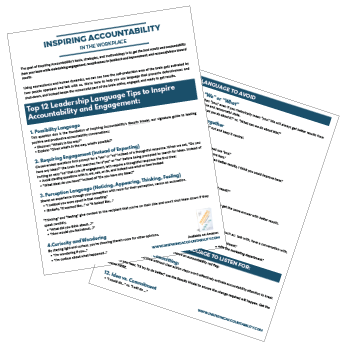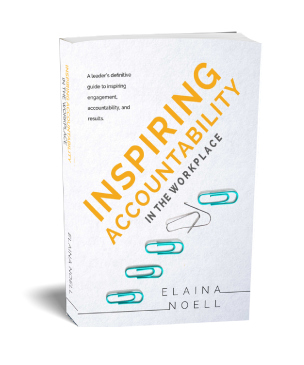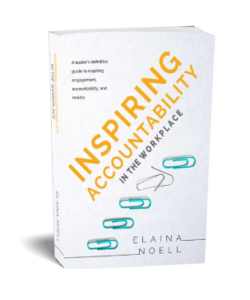
One Power Question to Improve Employee Accountability
The Inspiring Accountability approach aims to keep employees engaged in their work, receptive to feedback and change, and resourceful toward solutions.
One of the best tools to do that is to ask brain-engaging questions that start with “what” or “how.” In our signature accountability model, we feature two of our favorite questions to inspire accountability: “What’s in the way?” and “Given what’s in the way, what’s possible?”
When utilized consistently, these questions prompt employee-discovered development that makes meeting your expectations inevitable.
But what if an employee (or maybe you or someone you care about) is still stuck, unable to make the changes needed to deliver on what they say they will or want to do?
Keep reading to learn the one power question you can use when an employee (or anyone in your life) feels stuck or overwhelmed in progress toward an expectation.
WHY EMPLOYEES STRUGGLE WITH CHANGE
Any new expectation or goal requires a change in an employee’s default way of operating. When the change needed seems too out of reach, “anxious effort” can take over. This subtle fear originates in the reactive creature brain, responsible for the fight-flight-freeze response, which in this case looks like:
- Procrastination (fleeing to a task with a more assured success),
- Resistance (fighting or arguing against the change), or
- Forgetting, ignoring, or de-prioritizing the change request (freezing).
A tenant of Inspiring Accountability is that if it doesn’t feel doable, it doesn’t get done.
So what is a power question that can cut through when the change-fearing creature brain takes over and zaps receptivity and resourcefulness?
What can you do now to improve [this issue] by just 10%?
Many leaders would understandably scoff at accepting a 10% improvement toward an expectation that requires 90%+ execution. Not to worry!
This question is not about settling for 10% improvement. It’s about getting the employee back to being resourceful and engaged in SOME change so that they get back in a flow toward fully meeting your expectation. A 10% change transforms from the expectations feeling “not doable” to in-progress.
WHY IT WORKS
When the creature brain wins with protective resistance, sustainable progress is impossible until employee brain activity returns to the resourceful “executive function” part of the brain.
Let’s see the journey from a triggered and resistant employee to a resourceful and receptive problem-solver.
1. If it doesn’t feel doable, it doesn’t get done.
The creature brain values predictability over change or risk of failure. When an employee struggles to meet a new expectation, the subconscious has likely said “no,” putting up resistance that stops or slows progress. Often, this is because they do not feel confident they will be successful, and humans will go to great lengths not to take on what feels like inevitable failure.
Meanwhile, the resourceful part of the brain that allows us to respond thoughtfully (not just react fearfully) may really want to make this change. But when the creature brain gets triggered, the resourceful part of the brain goes offline, replacing receptivity and curiosity with fear and resistance. Essentially, you can’t experience fear and curiosity simultaneously–these states originate in competing parts of the brain.
Effective leaders re-engage the employee’s resourceful part of the brain, sparking the curiosity needed to come back from fear. Asking “What can you do to make this 10% better?” quells the fear by making the ask doable (Asking for 10% progress doesn’t trigger the threat of failing) while prompting curiosity, requiring the resourceful part of the brain to be active and assess a practical step forward.
2. Pondering a 10% change opens the door to 100% more receptivity.
The brain might feel overwhelmed and resist making the complete change, but when prompted to seek what is needed to make just a 10% change, it opens up new possibilities and receptivity.
It’s the difference between “no” (subconscious resistance) and “maybe” (feeling receptive to what’s possible). Anything other than “no” is a 100% difference in receptivity, just by asking about 10% improvement!
3. We likely will get way more than 10% improvement.
Once your employee feels receptive and resourceful, it will be almost impossible for them not to “accidentally” brainstorm how to make much more than 10% progress.
In this case, if you ask for one step, you’ll get ten! But if you asked for the ten steps upfront, you likely wouldn’t even get one.
Try using this power question next time someone seems stuck or is struggling to make progress. Your leadership can help get your employee back to a resourceful place so they can get in motion toward meeting your expectations.
Get Our Best Inspiring Accountability Resources!
Inspiring Accountability in the Workplace is available on Amazon as a paperback, eBook, and audiobook.
Or learn online with our signature course: The Brain’s Secrets to Inspiring Accountability Crash Course.
GET ACCESS TO OUR BEST TIPS
Download our Top 12 Leadership Language Tips to Inspire Accountability and Employee Engagement



